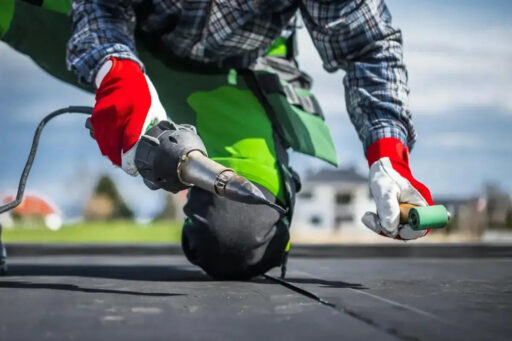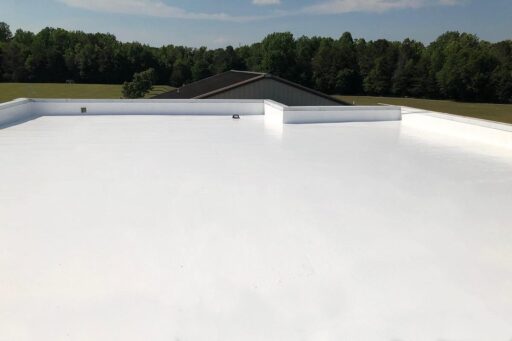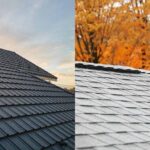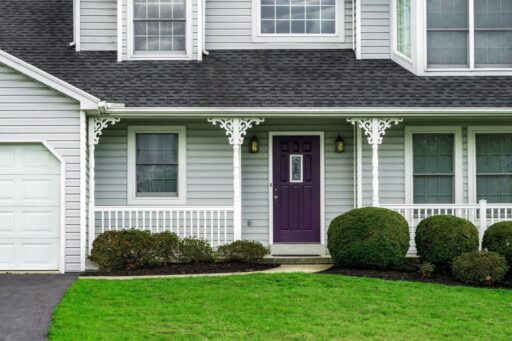Vancouver’s stunning scenery and unique climate are appealing, but with frequent rain and mild winters, choosing the appropriate flat roof for your building is crucial. Unlike sloped roofs that naturally shed water, flat roofs require specific considerations for drainage, waterproofing, and material selection. This comprehensive guide explores the most popular flat roof materials to help you make an informed decision for your Vancouver property.
1. Torch-Applied Modified Bitumen (Mod Bit)
Torch-Applied Modified Bitumen, commonly known as Mod Bit, is a popular roofing material for flat roofs. It combines the durability of asphalt with the flexibility of modern polymers. This material is known for its seamless waterproof barrier, created using a torch to apply layers of asphalt and felt. Mod Bit is often chosen for its cost-effectiveness and ease of installation, making it a favourite among budget-conscious homeowners and contractors.
Pros:
- Cost-effective: Mod Bit is one of the most affordable flat roof options.
- Easy to repair: Small tears and punctures can be readily patched up.
- Good resistance to UV rays and water: Modified bitumen offers decent protection against sunlight and rain.
Cons:
- Shorter lifespan (15-20 years): Compared to other options, Mod Bit roofs require more frequent replacement.
- Becomes brittle in cold weather: Cold temperatures can make Mod Bit stiff and prone to cracking.
- Lower fire resistance: Modified bitumen offers less fire protection than some other materials.
- Requires expert installation due to open flame use: The application process involves torches, necessitating a professional roofer for safety reasons.

2. Ethylene Propylene Diene Monomer (EPDM)
Ethylene Propylene Diene Monomer, or EPDM, is a synthetic rubber membrane renowned for its flexibility and long-lasting performance. Available in large sheets, EPDM minimizes seams, reducing potential leak points. EPDM roofing installation methods vary, typically involving full adhesion or a loose-laid attachment with gravel ballast. This material is often chosen for its impressive lifespan and adaptability to building movements and thermal expansion.
Pros:
- Long lifespan (30-50 years): EPDM boasts one of the longest lifespans among flat roof materials.
- Excellent resistance to UV rays and water: EPDM offers outstanding protection from sunlight and rain.
- Highly elastic for building movement: EPDM can accommodate slight movements in the building structure without tearing.
Cons:
- Higher initial cost than Mod Bit: EPDM has a slightly steeper upfront cost compared to Mod Bit.
- Susceptible to punctures: Sharp objects can easily puncture the EPDM membrane.
- Requires professional installation: Proper installation techniques are crucial for a successful EPDM roof.

3. Thermoplastic Polyolefin (TPO)
Thermoplastic Polyolefin (TPO) is a single-ply roofing membrane similar to EPDM, but typically comes in white or light colours. These colours reflect sunlight, reducing heat absorption and lowering cooling costs. TPO is known for its energy efficiency and long lifespan, making it a popular choice for environmentally conscious homeowners and commercial buildings. Installation methods are similar to those used for EPDM, ensuring a durable and reliable roof.
Pros:
- Similar lifespan to EPDM (30-50 years): TPO roof offers a long lifespan comparable to EPDM.
- Excellent resistance to UV rays and water: TPO provides outstanding protection against sunlight and rain.
- Energy-efficient due to high reflectivity: TPO reflects sunlight, helping to reduce cooling costs in hot climates
Cons:
- Slightly higher cost than EPDM: TPO has a slightly higher upfront cost compared to EPDM.
- Susceptible to punctures: Similar to EPDM, sharp objects can puncture the TPO membrane.
- Requires professional installation: Proper installation techniques are necessary for a successful TPO roof.

4. Polyvinyl Chloride (PVC)
Polyvinyl Chloride (PVC) is a robust single-ply roofing membrane known for its exceptional strength and durability. It offers superior resistance to chemicals and punctures, making it a suitable choice for industrial and commercial buildings. PVC roofing membrane is installed using heat-welding techniques, which create strong, watertight seams. This material is often chosen for its long lifespan and resilience against harsh environmental factors.
Pros:
- Longest lifespan (40-50+ years): PVC boasts the longest lifespan among common flat roof materials.
- Excellent resistance to chemicals, punctures, and fire: PVC offers superior protection against chemical spills, punctures, and fire compared to other options.
- Strong and durable seams: PVC roofing creates strong and reliable seams for a watertight roof.
Cons:
- Highest initial cost: PVC has the highest upfront cost compared to other materials.
- Becomes brittle in cold weather: Similar to Mod Bit, PVC can become stiff and prone to cracking in cold temperatures.
- Less environmentally friendly than EPDM and TPO: PVC production and disposal have a higher environmental impact compared to EPDM and TPO.

5. Spray Polyurethane Foam (SPF) Roofing
Spray Polyurethane Foam (SPF) roofing involves spraying a liquid polyurethane mixture that expands and cures to form a seamless, lightweight insulating and waterproofing layer. This material is known for its excellent insulation properties and ability to conform to irregular roof shapes. SPF roofing is typically chosen for its seamless application and energy-saving benefits.
Pros:
- Excellent insulation properties (reduces energy costs): SPF offers superior insulation, leading to lower heating and cooling costs.
- Conforms to irregular shapes: SPF roofing can be applied seamlessly to roofs with complex shapes or uneven surfaces.
- Seamless and lightweight application: SPF creates a continuous, lightweight roofing layer.
Cons:
- Requires specialized installation: SPF application requires trained professionals with specialized equipment.
- Susceptible to UV degradation without a topcoat: SPF needs a protective topcoat to prevent deterioration from sunlight exposure.
- Higher cost compared to traditional options: SPF generally has a higher upfront cost compared to traditional flat roof materials.

6. Built-Up Roofing (BUR)
Built-Up Roofing (BUR) is a traditional flat roof system consisting of multiple layers of asphalt and felt. This method offers superior waterproofing and a long lifespan with proper maintenance. BUR is known for its resilience and durability, making it a reliable choice for many commercial buildings. However, the installation process is labour-intensive and requires a structurally sound roof deck to support the heavy weight.
Pros:
- Long lifespan (30-40 years) with maintenance: Built-up roofs can last for decades with proper maintenance.
- Superior waterproofing: BUR offers excellent waterproofing capabilities when properly installed and maintained.
Cons:
- Labour-intensive and time-consuming installation: BUR installation involves multiple layers of materials and requires significant time and effort.
- Heavy weight requires a strong roof deck: The substantial weight of a BUR roof system necessitates a robust underlying structure to support it.
- Higher initial cost and maintenance needs: Built-up roofs has a higher upfront cost compared to some options and requires regular maintenance to maintain its lifespan.

Flat Roof Material Comparison
Consider factors like budget, desired lifespan, and climate to choose the best flat roof material for your project.
|
Flat Roof Material |
Pros |
Cons |
Typical Lifespan (Years) |
Estimated Cost (per m²) |
| Torch-Applied Modified Bitumen (Mod Bit) | Cost-effective, Easy to repair, UV/water-resistant | Shorter lifespan, Brittle in cold, Low fire resistance |
15-20 |
$20-$40 |
| Ethylene Propylene Diene Monomer (EPDM) | Long lifespan, UV/water-resistant, Elastic | Higher cost, Puncture-prone, Needs professional install |
30-50 |
$30-$50 |
| Thermoplastic Polyolefin (TPO) | UV/water-resistant, Energy-efficient | Higher cost, Puncture-prone, Needs professional install |
30-50 |
$35-$55 |
| Polyvinyl Chloride (PVC) | Long lifespan, Durable, Puncture/fire-resistant | High cost, Brittle in cold, Less eco-friendly |
40-50+ |
$40-$60 |
| Spray Polyurethane Foam (SPF) | Excellent insulation, Seamless, Lightweight | Needs expertise, UV degradation, High cost |
20-30 |
$50-$80 |
| Built-Up Roofing (BUR) | Long lifespan, Ponding water-resistant | Labour-intensive, Heavy, High cost, Maintenance needs |
30-40 |
$40-$60 |
Choosing the Right Flat Roof for Vancouver
The ideal flat roof for your Vancouver building is a harmonious blend of various factors:
- Budget: Mod Bit offers affordability, a serenade to your wallet, while PVC boasts longevity but comes with a higher initial cost, an investment to ponder.
- Desired Lifespan: EPDM, TPO, and PVC offer extended lifespans compared to Mod Bit, a lasting partnership.
- Aesthetics: TPO’s reflectivity can be beneficial in Vancouver’s climate, a cool and composed presence.
- Walkability: Consider walkable membranes or paver systems for roofs intended for foot traffic like rooftop patios, a dance floor for your enjoyment.
- Environmental Impact: EPDM and TPO are generally considered more eco-friendly than PVC due to their manufacturing processes, a consideration for the conscientious.
- Building Codes and Permits: Ensure your chosen material complies with local building codes and permit requirements, a dance best performed in harmony with the rules.
Professional Installation is Key
When it comes to flat roof installation in Vancouver, there’s no room for shortcuts. While the material selection is important, ensuring a flawless and long-lasting roof hinges on professional installation. That’s where Marks Roofing comes in. Our team of expert roofers in Vancouver boasts extensive experience and qualifications in flat roof installations. We understand the unique challenges presented by Vancouver’s climate and local building codes. We use only top-quality materials and employ the latest installation techniques to guarantee a watertight, durable, and energy-efficient flat roof for your property.
Conclusion
By understanding the strengths and weaknesses of various flat roof materials and Vancouver’s climate, you can make an informed decision. Proper drainage, ventilation, and professional installation are crucial for a long-lasting and reliable flat roof. This guide provides the knowledge to navigate the selection process and ensure your Vancouver flat roof protects your building for years to come.







